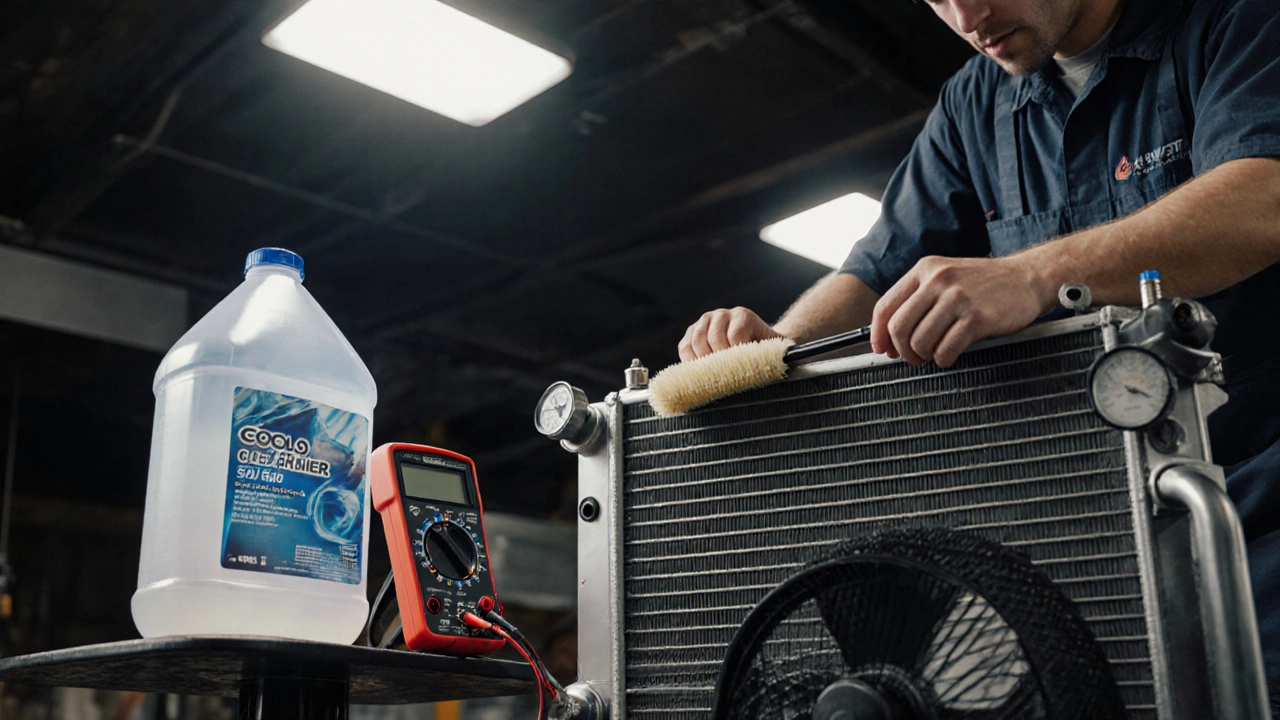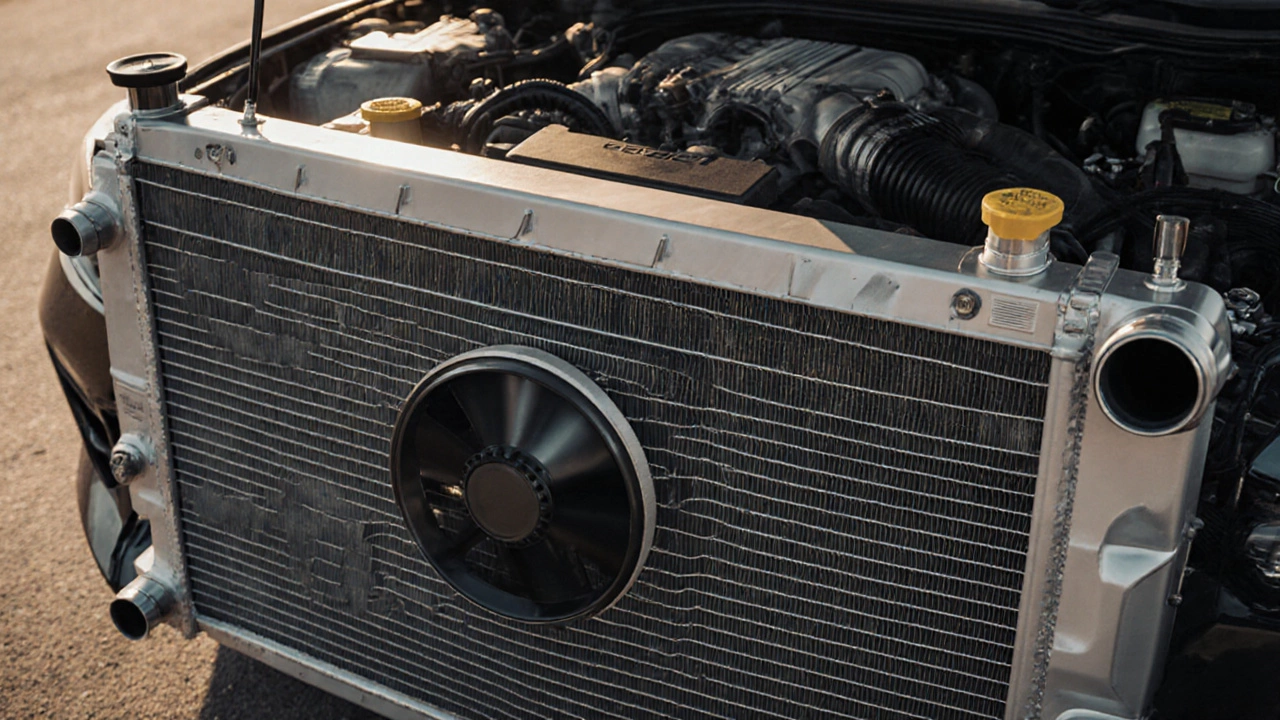Radiator & AC Health Checker
Check Your Symptoms
Select symptoms you're experiencing. This tool identifies if radiator issues are affecting your AC.
Critical Finding
Your symptoms indicate radiator issues affecting AC performance.
Based on article content: A clogged radiator reduces airflow to the condenser, causing weak AC performance and engine overheating.
System Health
Your radiator and AC systems appear balanced
Check condenser cleanliness and refrigerant levels as alternative causes.
Key Takeaways
- A clogged or leaking radiator can lower AC cooling because both rely on the same front‑end airflow.
- The condenser, not the radiator, actually cools the refrigerant, but a weak radiator fan reduces airflow for both.
- Regular coolant flushes, fan checks and condenser cleaning keep the AC and engine temperature in balance.
- Typical AC symptoms of radiator trouble include weak cold air, longer cooldown times and the engine overheating together.
- Follow the maintenance checklist below to prevent one system from pulling the other down.
Wondering whether your car radiator is a heat exchanger that transfers excess engine heat from the coolant to the surrounding air can affect the air conditioning system is the vehicle’s HVAC setup that cools interior air using a refrigerant cycle? The short answer is yes - but the relationship isn’t as direct as “radiator cools the AC.” Instead, both the radiator and the AC condenser sit side‑by‑side at the front of the car, sharing the same airflow and cooling‑fan resources. If one part gets clogged, under‑perfomed or fails, the other feels the strain.
How the cooling system and AC share airflow
When the engine runs, hot coolant circulates through the car radiator and releases heat to the outside air. At the same time, the AC’s condenser is a set of tubes where high‑pressure refrigerant releases its heat to the ambient air. Both the radiator and condenser have thin aluminum fins that need clean air to work efficiently. A single electric or belt‑driven radiator fan is a motor‑driven blade that forces air through the radiator and condenser when the vehicle is stationary or moving slowly pushes air through both components simultaneously.
If the radiator’s fins are dirty, bent or clogged with debris, the fan has to work harder to push air through the restricted space. That extra load reduces the volume of air reaching the condenser, so the refrigerant doesn’t shed heat as quickly. The result is a higher pressure on the AC side, which translates to weaker cooling inside the cabin.
When a radiator problem hurts AC performance
Here are the most common tell‑tale signs that a radiator issue is pulling down your AC:
- Weak or lukewarm air - Even on a hot day the blower feels like it’s only delivering “room‑temperature” air.
- Long cooldown time - The AC takes twice as long to reach the set temperature after you switch it on.
- Engine overheating together with AC trouble - The temperature gauge spikes while the AC still runs, indicating both systems are starved of airflow.
- Fan noise or stalling - A rattling or intermittent fan often points to a failing radiator fan that can’t keep both the radiator and condenser cool.
- Frequent refrigerant recharge - When the condenser runs too hot, the refrigerant can leak or degrade faster, leading to more top‑ups.

Key components linking the radiator and AC
| Component | Primary Role | Cooling Medium | Typical Issues That Affect AC |
|---|---|---|---|
| Car radiator | Removes engine heat from coolant | Water‑glycol Coolant is a water‑glycol solution that transfers heat from the engine to the radiator | Clogged fins, low coolant, fan failure |
| Condenser | Condenses high‑pressure refrigerant | R‑134a or newer refrigerants | Dirty fins, bent tubes, insufficient airflow |
| Radiator fan | Forces air through radiator and condenser | Electrical motor | Worn bearings, electrical faults, speed controller issues |
| Thermostat | Regulates coolant flow to radiator | Metal valve | Stuck open/closed, causing engine over‑cooling or overheating |
| Heater core | Provides cabin heat using engine coolant | Coolant | Clogged core reduces coolant flow, raising overall system temperature |
Maintenance checklist to keep both systems happy
- Inspect the front of the vehicle for leaves, bugs or road grime. Use a soft brush and a pressure nozzle to clean the radiator and condenser fins.
- Check coolant level and color every month. Top up with the manufacturer‑specified 50/50 mix and perform a full flush every 40,000 km (or every 2 years).
- Test the radiator fan operation: with the engine idling, the fan should kick in around 90 °C (194 °F). Listen for steady whirring; replace if it sputters.
- Feel the condenser surface after running the AC for 5 minutes. If it’s hotter than the radiator, the airflow is likely restricted.
- Examine the thermostat by feeling the upper radiator hose after a warm‑up. A sudden temperature rise indicates proper opening.
- Run the AC on “max cool” with windows closed for 10 minutes. If the cabin doesn’t drop below 22 °C (72 °F), suspect a condenser or fan issue.
- Schedule a professional pressure test of the AC system if you notice refrigerant loss - a failing condenser can leak under high heat.
- The engine temperature sensor monitors coolant heat and signals the ECU to activate the radiator fan when needed.
- The AC compressor pressurizes refrigerant before it reaches the condenser; listen for abnormal noises that could indicate a failing compressor.

Common myths debunked
- Myth: “The radiator cools the air‑conditioning refrigerant.”
Fact: The radiator only cools engine coolant. The AC refrigerant is cooled by the condenser, which merely shares the same airflow. - Myth: “If the AC is weak, I just need more refrigerant.”
Fact: Low refrigerant often masks a bigger problem like a dirty condenser or a failing fan caused by radiator issues. - Myth: “Coolant leaks don’t affect the AC.”
Fact: Low coolant raises engine temperature, causing the fan to run constantly. The fan’s reduced capacity can starve the condenser of air.
Bottom line
While the car radiator doesn’t directly chill the cabin, its health dictates how much air the AC’s condenser receives. A clean radiator, adequate coolant, and a fully functional fan provide the airflow foundation both systems need. By following the checklist above, you’ll avoid the classic scenario where the AC feels like it’s blowing warm air on a scorching summer day.
Frequently Asked Questions
Can a leaking radiator cause the AC to stop working?
A leak reduces coolant level, which can cause the engine to overheat. The fan then runs at full speed, but if the leak also damages the fan wiring, the airflow to the condenser drops, making the AC feel weak or stop altogether.
Should I clean the radiator and condenser together?
Yes. Since both components sit side‑by‑side, a single cleaning session clears debris from the radiator fins and the condenser tubes, restoring optimal airflow for engine cooling and cabin cooling.
Is it normal for the AC to make the engine run hotter?
Running the AC adds load to the engine and activates the fan, which can raise the temperature reading by a few degrees. However, if the temperature climbs rapidly or exceeds the red zone, investigate the radiator, fan and coolant levels.
What temperature should the coolant be after a flush?
After a proper flush and refill, the coolant should read around 90 °C (194 °F) when the engine is at normal operating temperature. The radiator fan should engage at this point.
Can I replace the radiator fan myself?
If you’re comfortable removing the front grille and disconnecting the electrical connector, a replacement fan can be a DIY job on most models. Make sure to secure the fan braces and test the fan speed controller before re‑assembling.

